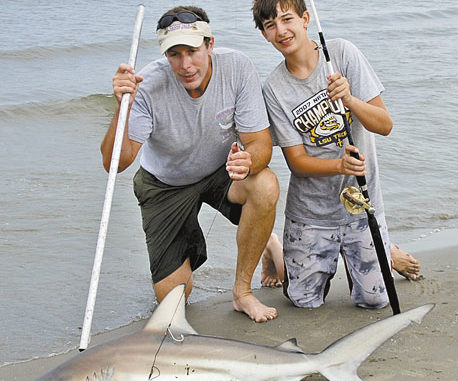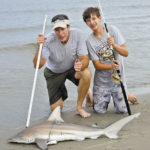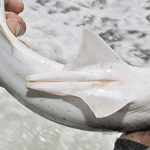
Durand Farms owners help wintering waterfowl, group says
The Gulf of Mexico is home to a lot of sharks, but only a few of them penetrate regularly into inshore waters. While tiger sharks prowl beaches and are especially common near the Chandeleur Islands, two of the most common inshore species are the bull shark and the blacktip shark.
The bull shark is an ugly, blunt-nosed thug that often penetrates fresh water. I have witnessed them as far up the Mississippi River as St. Francisville, and they have been recorded much farther up, as far as the Midwest.
The blacktip shark by contrast, is sleek and streamlined. Although it seldom penetrates far into freshwater rivers, it is the most common shark of coastal lakes and bays.
Carcharhinus limbatus, as scientists know the creature, is not a big shark, seldom reaching over 8 feet in length. The first word in the scientific name is Greek in origin and means “sharp,” or “sharpen,” and “nose.” The second half of the name is Latin, and means “bordered,” in reference to the black borders and tips on many of its fins.
The black fin tips are, of course, what the common name of the fish is derived from, and make it easy to identify. Besides the Cuban dogfish, a deepwater weirdo with spines on its fins and glowing eyes, only one other Gulf species of shark has black tips on its fins, the spinner shark. The major difference between the two is that the anal fin (the rear-most belly fin) in blacktip sharks never has a black tip. The spinner shark develops a black tip on the anal fin shortly after birth, and it remains black-tipped all its life.
Another difference between the two species is that the blacktip carries a distinct light-colored streak up each side, that is widest near the tail and tapers off going forward.
Both species are members of the requiem (cool name for a shark family — huh?) shark family, along with tiger sharks, bull sharks, oceanic whitetip sharks, as well as 10 other species in the Gulf of Mexico.
We have a lot of blacktip sharks in our lakes and bays for a very good reason. Louisiana is an important nursery ground for sharks, specifically blacktips. Nursery grounds are those areas where females bear their young and where the newborn sharks grow to be juveniles.
A little over 10 years ago, LSU fisheries scientists conducted a shark study in and near Timbalier Bay in Terrebonne Parish. Over a 3-year period, they made repeated sets of gill nets of various mesh sizes. Each shark captured was identified to be a newborn, young-of-the-year, juvenile or adult.
A total of 1,002 sharks from eight species were recorded. Blacktip sharks made up 56 percent of the catch, followed by Atlantic sharpnose sharks (15 percent), bull sharks (11 percent), finetooth sharks (7 percent). Bonnetheads, scalloped hammerheads, spinners and a lone lemon shark, none of which were newborns or young-of-the-year, made up the rest.
Roughly 80 percent of all the sharks captured in the study were newborns or young-of-the-year. Different species used the nursery area at different times of the year. Blacktips were present from May through September, but most common in June and July, prime fishing time in coastal lakes and bays.
Blacktip sharks bear living young. Their embryos start out with a yolk sac that soon develops into a placenta that taps into the mother shark’s food supply in her bloodstream. The female also produces liquid nutrients from the lining of her uterus (called uterine milk) that bathe the embryos.
On the subject of their reproduction, in 2007 a female blacktip in a Virginia aquarium that had never been near a male was found to be pregnant with a single pup. Genetic analysis confirmed that the pup was produced by parthenogenesis. In other words, she cloned herself.
Blacktip sharks are athletic fighters, and unlike many other sharks will actively attack artificial lures. Many an angler tossing soft plastics has been surprised by a heavy hit, almost instantly followed by a slashing leap by a 4-foot-long blacktip.
Blacktip sharks are also notorious for attacking hooked fish, at times becoming so persistent that fishing an area is difficult. About 90 percent of their diet consists of fish from a long list of species that includes their own young. In the Gulf region, their most numerous prey are listed as menhaden and croaker, but when they strip speck after speck off of an angler’s hook, the listed preference is in doubt.
Blacktip sharks and their close relative, the spinner shark, often feed on fish by attacking upward into a school so swiftly that their momentum carries them well into the air. While airborne, they typically spin in a corkscrew fashion three or four times before falling back into the water.
This is a spectacular sight, particularly for the larger spinner shark, which is found in more offshore waters than the blacktip.
Blacktip sharks make wonderful table fare, if anglers take proper care of them. Ideally, they should be gutted before icing and cleaned ASAP after the trip.
Remember that the limit on sharks is one 54-inch fork length shark per vessel (except for Atlantic sharpnose and bonnethead sharks, which are one per person).
Jerald Horst is author of six books on fish and seafood, including the acclaimed Trout Masters: How Louisiana’s Best Anglers Catch the Lunkers. His latest book is Game Warden: On Patrol In Louisiana.




